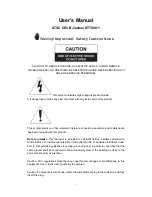
Remote Control - Commands
R&S NRP-Z28/-Z98
1170.8966.12
6.14
E-4
<sensor_function>
Description of the measurement mode
"XTIMe:POWer"
Trace
In the
Trace
mode, the envelope power can be recorded as a function to time. This is done by
sampling power over a time interval that can be specified by the user (
SENSe:TRACe:OFFSet:TIME
and
SENSe:TRACe:TIME
commands), and then assigning the power values that have been
determined to a number of pixels that are largely user-selectable (
SENSe:TRACe:POINts
command).
The time interval represented by a pixel is obtained by dividing the trace length by N-1, where N is the
number of pixels.
In the simplest case, each pixel is assigned a single sampling value which fully characterizes it. If
several sampling values are assigned to a pixel, the average power is made available for the time
interval in question.
In the
SENSe:TRACe:REALtime ON
setting (realtime processing), the measurement is performed
without chopper stabilization, i.e. a measurement consists of a single sampling sequence activated by
a trigger event, independent of the setting of the averaging filter. Otherwise a second sampling
sequence with reversed polarity of the detector output voltage is recorded, and the difference of the
measured values of the two sampling sequences is determined for each pixel. This suppresses low-
frequency noise and increases the measurement accuracy for the average power of the individual
pixels. The averaging factor determines how often the cycle is repeated.
Time intervals that are excluded from the measurement can be set at the beginning and the end of the
sampling window or timeslot in the measurement modes
Burst Average
and
Timeslot Average
.
(
SENSe:TIMing:EXCLude:STARt
and
-:STOP
).
The query yields
•
1
for
"POWer:AVG"
,
•
2
for
"POWer:TSLot:AVG"
,
•
4
for
"POWer:BURSt:AVG"
,
•
8
for
"XTIMe:POWer"
.
Default setting:
"POWer:AVG"
SENSe:POWer:AVG:APERture[?] 10e-6 to 0.3
SENSe:POWer:AVG:APERture
defines the time interval (sampling window) for the
Continuous Average
mode; measured values are continuously recorded in this interval. In manual operation, the default
setting of 20 ms in conjunction with the activated smoothing is sufficient in most cases.
Larger sampling windows are needed when the measurement shows fluctuations due to modulation. It
is then useful to adapt the size of the sampling window
exactly to the modulation period, which yields
an optimally stable display. If the modulation period varies or is not precisely known, the
Smoothing
function should also be activated (see command group
SENSe:POWer:AVG:SMOothing
). With
smoothing activated, approx. 5 periods within a sampling window are sufficient to reduce the
fluctuations caused by modulation to an acceptable degree; fluctuations are no longer perceptible with
more than 9 periods. With smoothing deactivated, the situation is considerably more unfavorable. In this
case, 300 instead of 5 periods are required, and the fluctuations do not disappear completely until there
are 3000 or more periods.
The query yields the currently set width of the sampling window in seconds.
Default setting:
0.02 [s]
SENSe:POWer:AVG:BUFFer:SIZE[?] 1 to 1024
SENSe:POWer:AVG:BUFFer:SIZE
sets the buffer size for the buffered
Continuous Average
mode.
The query yields the current buffer size for the buffered
Continuous Average
mode.
Default setting:
1
















































